After growing sweet corn organically for over 30 years, I’ve learned that healthy corn starts with early attention to potential problems. Pests and diseases can quickly damage a crop if you don’t know what to look for—or when to act. In this post, I’ll share the most common sweet corn troubles I’ve faced in the garden and how I manage them using time-tested organic methods. Whether you’re growing one row or an entire patch, these tips come from hands-on experience and will help you grow strong, productive corn without synthetic chemicals. Let’s dig in and take a closer look at what to watch for—and what to do when problems show up.
To come to harvest quickly corn requires warm temperatures, rich soil, and even, regular watering. Corn is wind-pollinated so planting in blocks or multiple rows to ensure pollination is important.
Here is a troubleshooting list of possible corn-growing problems with control and cure suggestions: (Read to the bottom of this post for corn-growing success tips.)
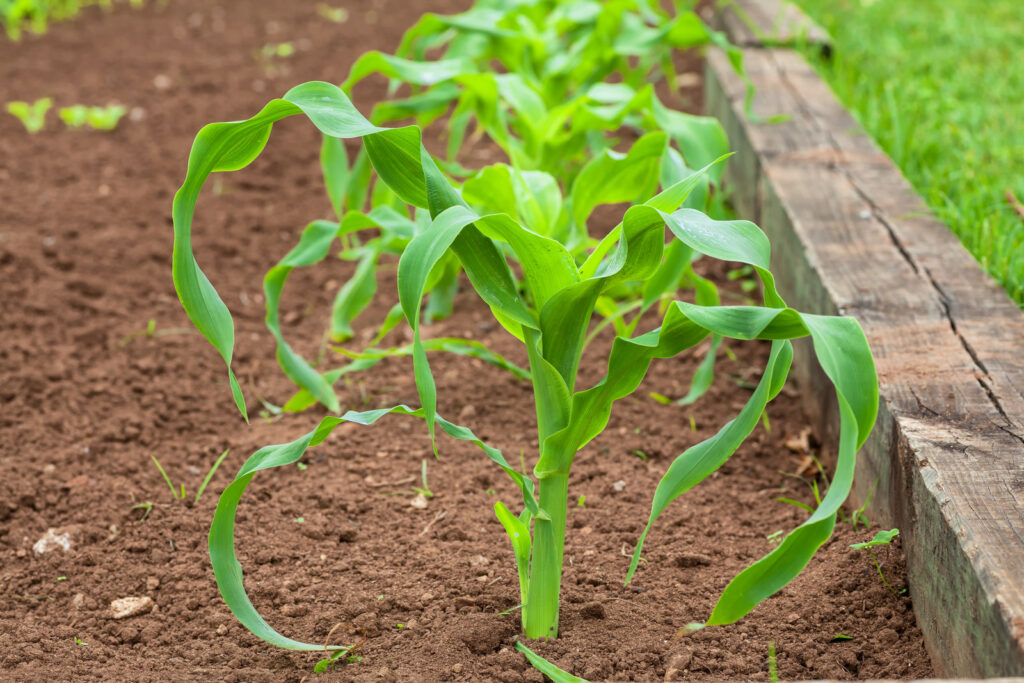
Corn problems and solutions:
Seed and seedling problems
Seeds do not germinate; seedlings do not emerge.
Soil may be cold or damp. Plant later when the soil and temperatures are warmer; make sure the soil is well-draining by adding aged compost and organic matter to the soil.
Insides of seed and young plants are eaten.
Corn wireworm or the seed corn maggot is eating the seed. The corn wireworm is the larvae of the click beetle; the click beetle is reddish brown or black to ¾ inches long. Wireworms are brown or yellow and leathery to 1½ inches long. The seed corn maggot is a yellowish-white legless maggot, the larvae of a fly. The maggot feeds on the inside of the sprouting seed. Cultivate the planting bed in the fall to expose larvae to birds. Spade the corn bed and let it lie fallow every third season. To trap: use pieces of potato on a spike setting them 2 to 4 inches into the soil; check the traps twice a week. Pick and destroy wireworms and maggots from the potato.
Seedlings are cut off near the soil surface.
Cutworms are gray or brown grubs that hide in the soil by day and feed at night. Handpick grubs from the soil at the base of plants. Remove weeds and keep the garden free of plant debris. Place a 3-inch cardboard collar around the stems of seedlings and push the collars 1 inch into the soil.
Seedlings are uprooted.
Crows and birds will pull up seedlings to feed on the seed. Cover seedlings with bird block or row covers until they are established. lacewing flies, ladybugs, and praying mantis.
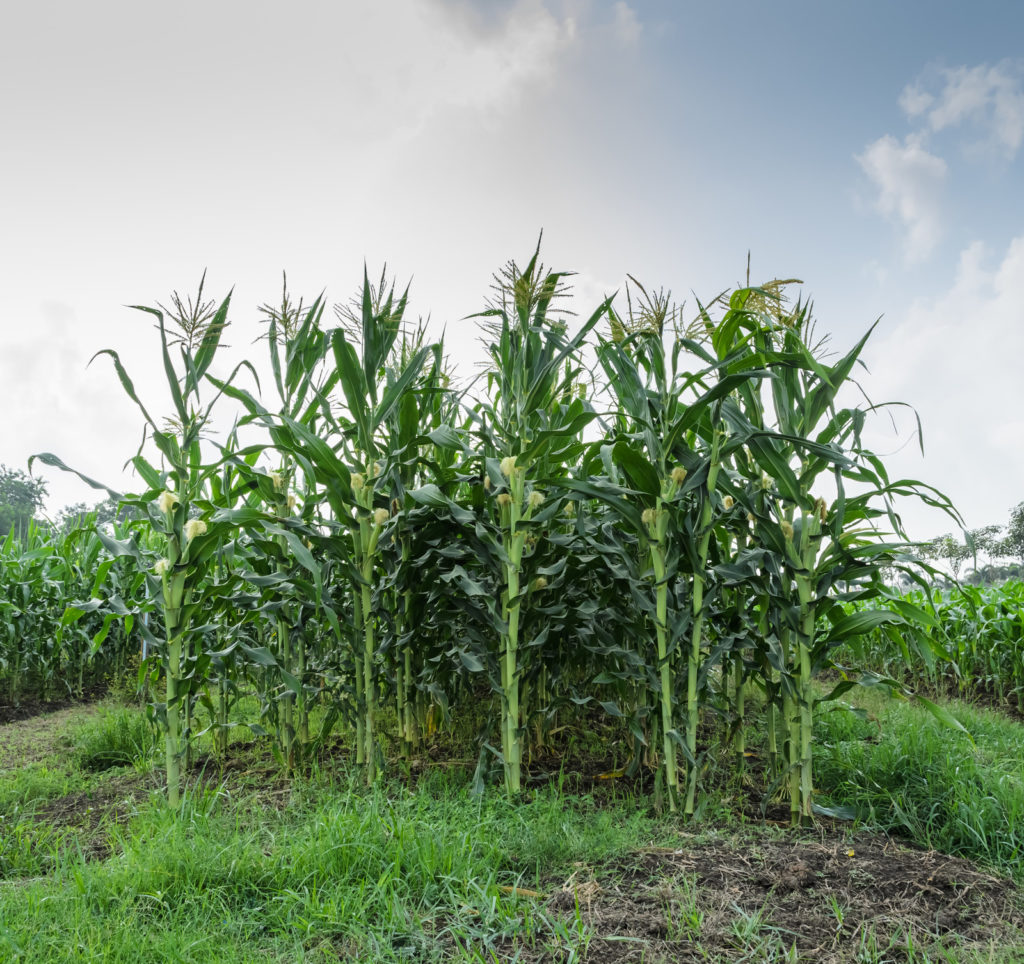
Leaf problems
Tiny shot holes in the leaves.
The corn flea beetle can riddle leaves with small holes and transmit Stewart’s wilt, a bacterial disease that leaves the plant’s vascular system clogged with slime; infected plants wilt, become stunted, and die. Pick off beetles; cultivate the garden to disturb the insect life cycle. Spray with pyrethrum or rotenone.
Large holes in leaves.
Armyworms, corn earworms, various beetles, and grasshoppers eat corn leaves and foliage. Handpick insects and destroy or place them in soapy water. Loss of a small amount of leaf tissue will not reduce yields. Plant early corn varieties to avoid armyworms. Use commercial traps with floral lures. Cultivate in the fall to expose larvae.
Holes in leaves near whorls.
European corn borer; larvae are light brown to pinkish caterpillars with dark brown heads and dark spots on the body; the adult moth is light brown with a ¾-inch wingspan. Larvae feed on corn whorls and then bore into stalks. They also feed on tassels and kernels. Handpick and destroy larvae. Apply Bacillus thuringiensis. Remove and destroy all infested stalks at the end of the season.
Leaf edges roll inwards.
Soil moisture may be inadequate. Corn makes rapid growth after ears form and begin to mature; this requires consistent moisture. Water corn deeply, up to 2 or 3 hours at a time. When the soil dries to a depth of 4 inches, water again. Place 2 to 3 inches of organic mulch on the planting bed to conserve moisture.
Leaves are mottled and streaked yellow and green; leaves yellow and die along the margins; growth is slowed or stunted.
Mosaic virus and maize dwarf mosaic virus has no cure. It is spread by beetles. Plant mosaic virus-resistant varieties. Destroy infected plants and keep weeds and grasses down that host aphids beetles. Do not handle healthy plants after infected one.
Yellow striping on leaves.
Stewart’s wilt is a bacterial disease that results in the plant’s vascular system becoming clogged with slime; infected plants will yellow, wilt, become stunted, and die. Control flea beetles that spread the disease. Pick off beetles; cultivate the garden to disturb the insect life cycle. Spray with pyrethrum or rotenone. Plant disease-tolerant varieties.
Leaves have purple margins starting with leaves at the bottom of the plant; the plant may be stunted.
Phosphorus deficiency. Perform a soil test; add bonemeal to the top of the planting bed at a rate of 2 to 3 pounds per 100 square feet. Using a commercial fertilizer rich in phosphorus 5-10-5 is good.
Reddish-brown blisters on the top of leaves and stalks; leaves may turn yellow.
Rust is caused by a fungus; rusty-colored spores grow on the plant. Rust favors warm, humid weather. Plant rust-resistant varieties. Avoid overhead irrigation. Prune away infected leaves.
Grayish or tan oval spots on leaves.
Northern corn leaf blight and southern corn leaf blight are fungal diseases that favor wet conditions. Add aged compost or organic material to planting beds to keep the soil well-drained. Avoid overhead irrigation. Keep the garden clean of debris and weeds which can harbor fungus spores. Plant disease-resistant varieties.
Leaves yellow as tassels form.
Insufficient nitrogen. Side-dress plants with aged compost. Water with compost tea or fish emulsion. Add aged compost to planting beds in advance of planting.
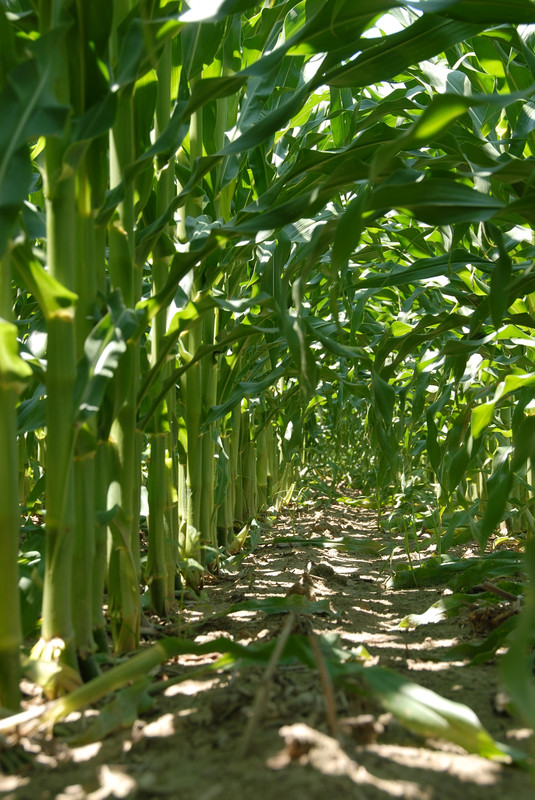
Whole plant problems
Stalks fall over.
European corn borers are grayish-pink caterpillars with dark heads (more below); they can tunnel through stalks and weaken them. Use Bacillus thuringiensis and garden cleanup to control borers. Too much nitrogen also can leave stalks lush and green but weak. Test soil. Adjust fertilization. Avoid using fertilizers too rich in nitrogen. Feed plants with aged compost.
Stalks and leaves are deformed, bent over, or may fail to unfurl; plants are stunted.
Aphids are small soft-bodied insects–green and gray–that cluster on the undersides of leaves. Aphids leave behind a sticky excrement called honeydew; black sooty mold may grow on the honeydew. Spray away aphids with a blast of water; use insecticidal soap; aluminum mulch will disorient aphids. Aphid predators include
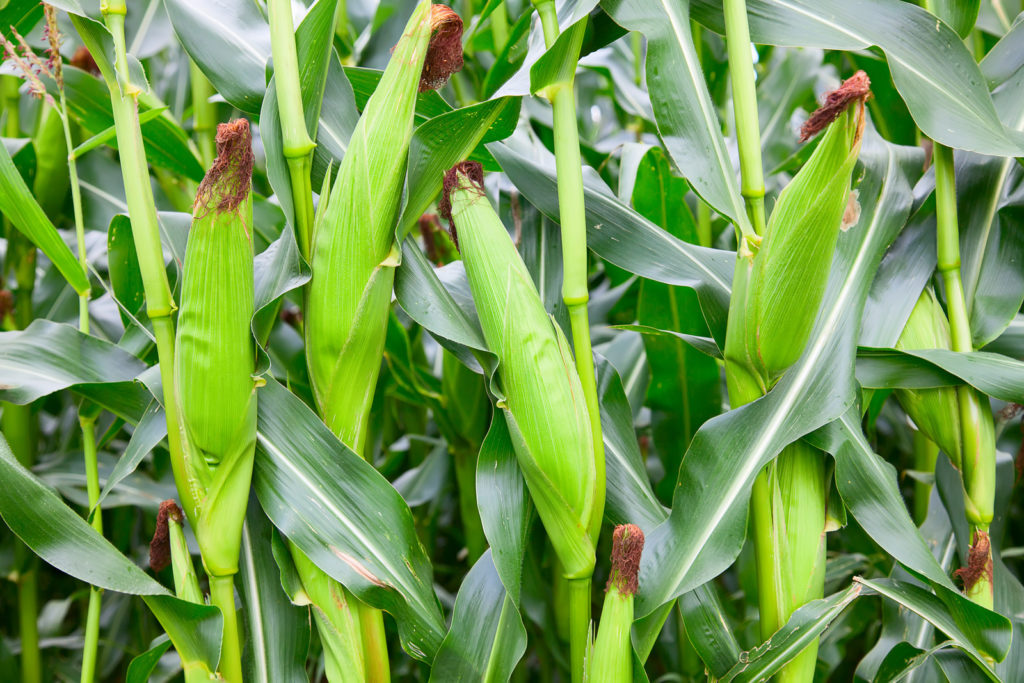
Ear problems
Gray-white gnarled growths or galls on ears and leaves.
Corn smut is a fungus disease. Remove and destroy galls as soon as found when they are still white. Do not allow black powdery spores from galls to fall into the soil. Plant disease-resistant varieties. The problem is more common in late harvests.
Ears are only partly filled, silks are chewed short or clipped off.
Earwigs, Japanese beetles, and corn rootworm beetles feed on silks which prevents pollination or causes poor kernel development. Check ears daily for earwigs and beetles; handpick and destroy. Spray plants with hot pepper and garlic repellant. Place traps around the garden to collect pests. Keep the garden free of weeds and debris.
Incomplete kernel development; ears partially filled with ripe kernels; shriveled kernels.
Each individual kernel must be pollinated; kernels that don’t receive pollen will not fill out. Pollen from male tassels must reach the female silks. Several possible causes: (1) Poor pollination can happen when not enough plants are planted; plant at least 3 to 4 rows at least 8 feet long. (2) Hot weather or high winds during pollination. Pollen sheds 2 to 3 weeks before harvest. (3) Insufficient soil moisture; keep corn evenly moist, especially from silking to harvest. (4) Inadequate fertilizer or soil fertility; add aged compost to planting beds. Check for potassium deficiency. Plant varieties adapted to your area. (5) Birds are eating kernels; put paper bags over ears after pollination.
Worms eat down through kernels; ears look brown and eaten.
Corn earworm is a brown-headed caterpillar with lengthwise stripes to 2 inches long; the adult is a night-flying moth with brownish or olive wings and bright green eyes. The worm finds its way into the whorl of the corn plant to burrow down and eat developing tassels. Apply 20 drops of mineral oil just inside the ear tip 3 to 7 days after silks first appear. Break off the wormy end of the ear and discard. Plant early-maturing varieties to avoid earworms; varieties such as ‘Country Gentleman’, ‘Golden Security’, and ‘Silver Cross Bantam’ have long, tight husks. Use commercial traps. Handpick caterpillars and destroy them. Dust with Sevin.
Stalks produce small ears.
Plants are spaced too close together; plant early varieties at least 8 inches apart; space later varieties 12 to 15 inches apart.
Popped kernels, kernels look like popcorn.
Seed coats will sometime break at the weakest point. No cure. Plant another variety.
Kernels are pink and moldy; brown lesions on stalks near joints; stalks are rotten inside.
Fungi can cause rots. Keep the garden free of plant debris and weeds that can harbor fungus spores. Remove diseased plants. Make sure soil is well-drained; add aged compost to planting beds twice a year. Keep soil evenly moist but not wet.
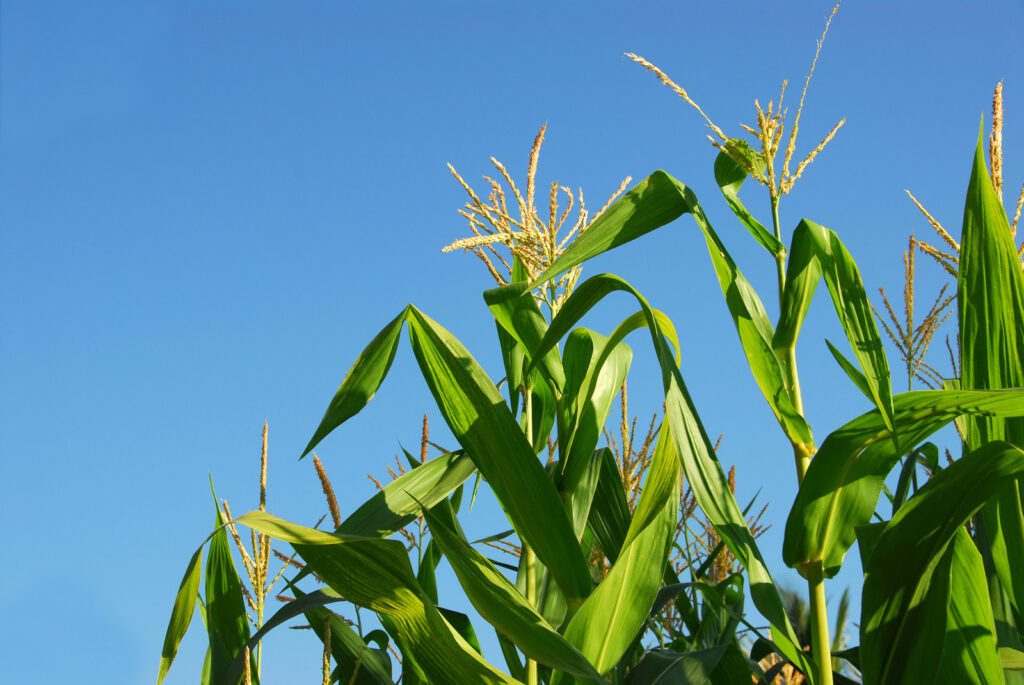
Corn growing success tips
Planting
Grow corn in full sun. Corn requires moist, well-drained soil rich in organic matter. Prepare planting beds or planting mounds with plenty of aged compost. Additionally, sprinkle planting beds with nitrogen-rich cottonseed meal or soybean meal, about 3 pounds per 100 square feet. Plant corn in mounds or hills–thin each hill to 3 plants–or in raised beds. Mounds and raised beds warm early in the season and are well drained.
Block planting
Plant corn in blocks or short, multiple rows. Space plants about 15 inches apart with at least 4 rows and at least 4 plants in each row. Block planting will improve pollination; corn drops pollen from its tassels down to the silks in the ears below. Planted in a block, corn pollen that drifts on the breeze is more likely to find its way to an ear and silks below.
Plant time
Sow corn in the garden after the last frost in spring; it is best to plant corn when the soil has warmed to at least 62°F. Succession plant corn every two weeks for a continuous harvest. Corn can be started indoors 3 to 4 weeks before planting out; start seed in biodegradable pots so that roots are not disturbed when transplanted.
Care
Corn requires even, regular watering. Use a soaker hose to keep corn moist, about 2 inches of water each week. Add 1 to 2 inches of mulch between stalks to conserve soil moisture. Side-dress corn with aged compost or a balanced fertilizer 1 month after planting and again when the tassels form.
Harvest
Begin picking corn 3 weeks after the first silks appear. When the silks brown and begin to dry the corn is ripe. Check the ears to see that they are filled to the tip with kernels. To further test for ripeness, press a kernel with your fingernail, if the juice is milky white the ear is ripe.
After decades of growing and cooking sweet corn straight from my garden, I’ve discovered that there’s no shortage of delicious ways to bring out its natural sweetness and flavor. Whether it’s freshly picked Bodacious or tender baby corn, how you cook and serve it can make all the difference. In this post, I’m sharing seven tried-and-true methods I’ve used in my own kitchen—from classic boiling and grilling to more creative twists like skillet-charred corn or corn fritters. These are the techniques I rely on every summer when the harvest is at its peak and the goal is simple: let the sweet corn shine.
Overview Post: How to Grow Corn: The Complete Guide from Planting to Harvest
🌽 Related Posts: Explore More on Growing Corn
🌱 Getting Started with Corn
- Starting Sweet Corn from Seed: Proven Tips for Early Success
- When and Where to Plant Sweet Corn for the Best Yield
- Planting Sweet Corn: Spacing, Block Planting, and Depth Tips
- Can You Grow Corn in Containers? Yes-Here’s How
💧 Watering, Feeding, Pollination & Care
- How to Water and Fertilize Sweet Corn for Maximum Yield
- Sweet Corn Pollination: Natural and Hand-Pollination Tips
- The Best Companion Plants for Sweet Corn (And What to Avoid)
- What To Do When Corn Falls Over (Lodging Tips)
🌽 Harvest, Storage & Serving
- How to Harvest and Store Sweet Corn
- How to Store Fresh Corn and Preserve It for Later
- Seven Easy Wasy to Cook and Serve Sweet Corn
🐛 Pests, Diseases & Troubleshooting
🌟 Sweet Corn Varieties
Garden Planning Books at Amazon:
- Vegetable Garden Almanac & Planner
- Kitchen Garden Grower’s Guide Vegetable Encyclopedia
- Vegetable Garden Grower’s Guide
- Tomato Grower’s Answer Book



